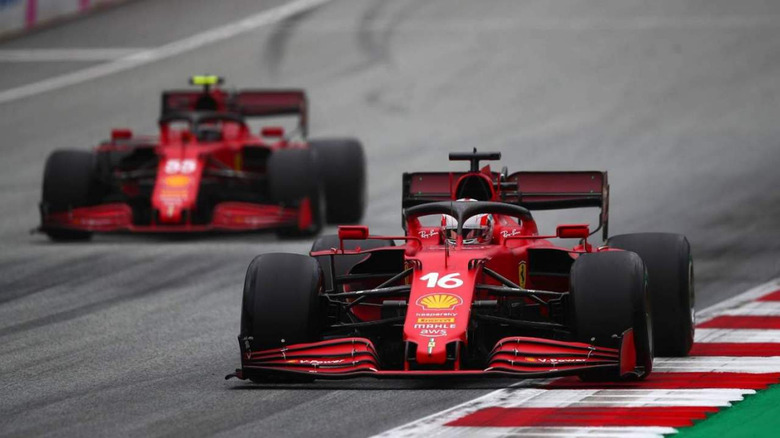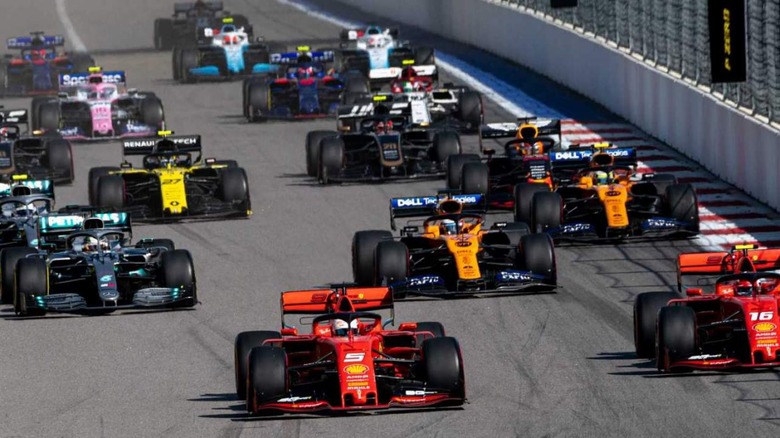Tragedies That Changed Formula 1 Forever
Formula 1 is the pinnacle of motorsports and many consumer automotive technologies trickle down from the high-octane racing that has gripped generations for years. The high drama of street circuits, fierce duels between rival drivers, and even teammate battles have kept automotive fans on the edges of their seats every season. While the glitz and glamour of the sport are overwhelming, one cannot deny the dangers involved in racing at break-neck speeds.
Note: This article contains videos of wrecks and details about the resulting loss of life. Some readers may find these stories upsetting.
There have been countless F1 racing accidents over the years that have resulted in the implementation of new safety measures. Unfortunately, these changes often follow the tragic loss of life. Here are some of the most heart-wrenching tragedies that shook the F1 world and shaped it into the sport it is today.
Ronnie Peterson caught up in pile-up
Swedish racing driver Ronnie Peterson was one of the greatest drivers of the '70s. He died, unfortunately, following a multi-car pile-up during the 1978 Italian Grand Prix. The 34-year-old Peterson was in the wrong place at the wrong time when James Hunt, driving a McLaren in 10th position, was nudged by Riccardo Patrese's Arrows in 12th position.
This sent the McLaren in to Peterson's Lotus as it hurled toward the right-hand side barriers and crushed the front end of the car (via Auto Sport). Vittorio Brambilla, starting from the back of the pack, couldn't avoid the pile-up and crashed into Peterson's car, which then burst into flames, sealing the driver's fate.
This incident changed how medical treatment on Formula 1 race tracks is administered. Medical vehicles were introduced that follow the Formula 1 cars to provide emergency treatment when drivers are injured (via Formula1). The importance of this change was underscored when Michael Schumacher received near-instant medical treatment at the 1999 Silverstone GP.
As well, and likewise following Peterson's tragic death, changes were made to the Monza track to improve racing safety; the barriers were moved further back, and the pit lane was redesigned (via Wikipedia).
Passing away of legendary Ayrton Senna
Three times world champion Ayrton Senna was one of the greatest F1 racers of all time, but on the fateful day of the Imola weekend race, he left us forever. The tragedy happened during lap 7 of the 1994 San Marino Grand Prix when approaching the Tamburello corner; Senna slightly overshot the corner and collided with the bare concrete wall at 131 MPH (via Formula Nerds).
The 34-year-old Brazilian suffered three major injuries, including being struck in the helmet by a rebounding wheel and pierced by a loose suspension piece. The racer was carrying the Austrian flag in his car to pay homage to Ratzenberger, who had died on the same weekend during the qualifying session.
Two fatal crashes on the same weekend at the same race track decimated the spirits of Formula 1. The loss of one of the greatest sportsmen in racing history led FIA to take stringent steps to ensure high-speed impacts do not lead to fatalities. Among other things, Formula 1 car design was overhauled to ensure the parts that disintegrate during a crash won't injure drivers in the future.
Jules Bianchi's loses control on slick track
Rainy weather during the 2014 Japanese Grand Prix resulted in track conditions that would ultimately cost 25-year-old Jules Bianchi his life. The French driver wasn't able to slow down sufficiently under the double-waved yellow flags, losing control one lap later at the same corner where Adrian Sutil's wrecked car was being retrieved with a crane. Bianchi's vehicle collided with the crane, causing severe head injuries that put the driver into a coma and, nine months later, claimed his life (via GQ).
The incident was a shocker for the Formula 1 fraternity. Following Ayrton Senna's crash (detailed above), steps had been taken to ensure the safety of other drivers when a car is parked in a dangerous position or being recovered from the track.
Bianchi's crash prompted race directors to increase safety measures, red-flagging future races when their tracks need to be cleared. Likewise, the Halo design that now protects drivers' heads is a byproduct of this ill-fated crash; it has proved vital in keeping drivers safe in the years since, as we've seen multiple times now (via Motorsport).
Ill-fated Tom Pryce
The 27-year-old Welsh F1 driver Thomas Maldwyn Pryce wasn't originally supposed to race at the 1977 South African Grand Prix, but fate had other plans. A teen marshal, Frederick Jansen Van Vuuren, was running across the track to assist another driver whose car was on fire when he crossed into Pryce's path.
The driver's car collided with Frederick at nearly 168 MPH; the incident was so severe that Frederick died on impact. During the wreck, Pryce was hit by the fire extinguisher Frederick had been carrying, causing the driver's helmet strap to partially decapitate him. Pryce, too, died at the scene.
Following this horrendous tragedy, F1 authorities mandated strict protocols over marshals jumping on the racetrack while other cars are still operating close to racing speeds (via Sportscasting). This paved the way for a more streamlined display of yellow and red flags to ensure all drivers and teams are quickly made aware of what's going on.
Roland Ratzenberger's tragic 1994 Imola crash
The 33-year-old Austrian racing driver Roland Ratzenberger experienced a fatal high-speed crash during the qualifying round for the 1994 San Marino Grand Prix. Prior to the fatal crash, Ratenzberger went off track, which, unknown to him, caused some damage to his car's front wing. Unfortunately, the wing later broke free and became lodged under the Simtek F1 car while it was moving at more than 190 MPH.
Ratzenberger was unable to control the vehicle and crashed into a concrete wall at the high-speed Villeneuve corner, sustaining a fatal skull fracture and multiple injuries. This heart-wrenching crash happened just a day before Senna's fatal accident on Imola weekend (via Motorsport).
Roland's crash was a stark reminder of the dangers Formula 1 drivers face while going into sharp corners at high speeds. This tragedy led to a safer barriers layout, especially at high-speed chicanes (serpentine curves) on F1 tracks. These risky spots were redesigned to feature cushioning and impact-absorbing structures, helping protect drivers in cases of severe impacts.
Gilles Villeneuve's ill-timed pass
Canadian racing driver Gilles Villeneuve was the victim of a horrendous 140 MPH crash at the 1982 Belgian Grand Prix at Zolder, where he may have been attempting to improve his qualifying performance in the final minutes of the race (via Motorsport). Didier Pironi was faster than Villeneuve, who was driving with his last set of race-qualifying tires.
Villeneuve saw an opportunity when Jochen Mass slowed down ahead of him at the curve, and, trying to pass to the right, his car's left tire touched the rear of Mass's car. This caused the driver's vehicle to fly skywards approximately 330ft, then nosedive with a massive impact. The front of the chassis was ripped apart, and Gilles sustained fatal injuries, surviving briefly on life support before succumbing to his injuries.
The loss of the talented Ferrari driver shocked the Formula 1 world and affected how F1 cars would evolve in the coming years. Vehicle aerodynamics were redesigned to keep cars glued to the track, preventing a repeat of Gilles' fatal accident. As a result, present-day F1 cars rarely leave the tarmac even after wobbling due to contact with other cars at high speeds.

